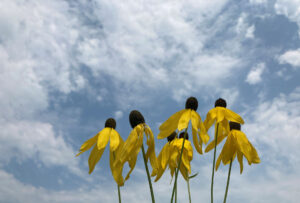Did you know that you can find native plants in full bloom before the snow has melted? Late April to May is actually a great time to find certain species of native wildflowers. In fact, these plants have some of the most distinct blooms and play a key role in the ecosystem during a time when food is otherwise scarce for pollinators.
Spring ephemerals are a unique type of flowering plant that are commonly found in deciduous forests. They can be thought of as our first sign that winter is finally coming to a close and warmer weather is around the corner. They display some of the most iconic blooms, such as is the case with Dutchman’s breeches (Dicentra cucullaria), which show off flowers that resemble puffy white pantaloons. In another example, the Large-flowered Bellwort (Uvularia grandiflora) blooms are bright banana yellow, with petals that dangle in corkscrew-like curls.


These beautiful little plants are more than just eye-catching, they’re a vital source of food for pollinators. In particular, queen bees rely on ephemerals for a delicious breakfast to kickstart their springtime activities after months of dormancy and hibernation. To point out just how key these ephemerals are, some species of bee rely on only a few of these flowering plants for pollen. Spring Beauty Mining Bees (Andrena erigeniae), for example, rely on only a couple of species from the Claytonia genus for food. You can identify one of these bees hard at work by the lavender-colored collections of pollen on their legs.
If you are itching to get outdoors this spring, try finding some of these spring ephemerals in nearby wooded areas. Keep and eye out for:
· Jack-in-the-Pulpit (Arisaema triphyllum)
· Wild Ginger (Asarum canadense)
· Spring Beauty (Claytonia virginica)
· Dutchman’s Breeches (Dicentra cucullaria)
· Sharp-lobed Hepatica (Hepatica acutiloba)
· Virginia Bluebells (Mertensia virginica)
· Bloodroot (Sanguinaria canadensis)
· Skunk Cabbage (Symplocarpus foetidus)
· Rue Anemone (Thalictrum thalictroides)
· Large-flowered Trillium (Trillium grandiflorum)
· Large-flowered Bellwort (Uvularia grandiflora).




If you’d like a pop of springtime color and added spring pollinator support, try introducing spring ephemerals to your own yard! It is best to plant these in shaded areas with dappled sunlight, such as in deciduous forests or woodland edges. They prefer moist soil and can be planted as soon as the ground has thawed.
Have a sunnier yard? You’re still in luck! Some ephemeral species such as Pasque Flower (Anemone patens) and Prairie Shooting Star (Dodecatheon meadia) prefer the prairie to woodlands and are another sure sign of spring! Followed not long after by the unique blooms of Prairie Smoke (Geum triflorum) and Blue-eyed grass (Sisyrinchium campestre).
A limited selection of ephemerals is available in our shop this spring, so don’t wait to add them to your garden this year!




